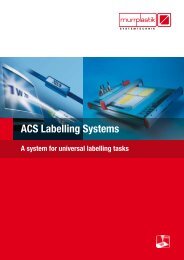Terminal block labelling - Kablo Etiketi
Terminal block labelling - Kablo Etiketi
Terminal block labelling - Kablo Etiketi
You also want an ePaper? Increase the reach of your titles
YUMPU automatically turns print PDFs into web optimized ePapers that Google loves.
Material properties<br />
Comparative properties of polycarbonate and polyamide label plates<br />
For your label plates Murrplastik Systemtechnik uses high-quality polycarbonate meeting the requirements laid<br />
down by UL94 for the top fire classification V0. This offers clear advantages over polyamide as used by our<br />
competitors.<br />
Polycarbonate (PC) is used in applications requiring a high-quality surface finish in respect of scratch resistance<br />
and gloss level. As such, PC is widespread in the automotive sector, where examples of its use include headlight<br />
lenses and PC/ABS blends in the interior. By contrast, polyamide (PA) is rarely found as a blend in interior fittings.<br />
Polyamides are, however, prevalent under the bonnet, for example, where less significance is attached to the<br />
appearance.<br />
For use as a label plate polyamide has another unfavourable property: ambient water absorption of approx. two<br />
weight percent. This can cause dimensional variations (small dimensions at low temperatures and low air humidity,<br />
large dimensions at high temperatures and high air humidity). While this may not affect the dimensions of the<br />
label plates too severely, it does unduly impact on the properties of the material. Indeed, if water absorption is<br />
low the material is very brittle and tends to break (e.g. when latching onto a terminal <strong>block</strong>). Conversely, if water<br />
absorption is high then it is very soft and it may be difficult to separate plates from each other (tear response).<br />
In terms of its inscription properties polycarbonate is streets ahead of polyamide. Since PC is more prone to<br />
chemical reaction it lends itself well to ink and also laser inscription. Whereas PA scarcely reacts to the energy<br />
application of laser light the colour change achieved with PC is outstanding.<br />
The chemical reactivity of polycarbonate during inscription makes it an excellent abrasion-resistant surface for<br />
inks. If the resistance to abrasion and water is good in both materials then the inscription on polyamide wears<br />
off significantly if comes into contact with oil, petrol or spirit. Polycarbonate, however, is also resistant to these<br />
substances.<br />
Material description<br />
Material Description<br />
Polycarbonate (PC): Excellent surface gloss and transparency (natural), high mechanical<br />
strength and dimensional stability under heat, outstanding electrical and<br />
dielectric properties, superb dimensional accuracy and low water<br />
absorption. Impact resistance up to approx. 150 °C and, as a general<br />
rule, PC is self-extinguishing without the addition of fire-retardants.<br />
Polyamide (PA): Broad range of properties covered by different types (PA 6 and PA6.6<br />
are frequently used). Generally good electrical and mechanical properties<br />
with resistance to impact and abrasion being particularly strong.<br />
When dry, PA is sensitive to impact. Water absorption renders PA flexible.<br />
Polyvinyl chloride (PVC): Soft PVC is made from polyvinyl chloride, softeners and process<br />
materials, e.g. stabilisers and lubricants. PVC is resistant to corrosive<br />
saline solutions and most acids.<br />
Thermoplastic polyurethane (TPU) : Outstanding features of this material include its high flexibility even<br />
at low temperatures, high continuous operating temperature, high<br />
resistance to tear propagation and very good restoring forces, high<br />
resistance to grease, oil, solvents, high-energy radiation and ultraviolet<br />
light.<br />
184 Murrplastik Systemtechnik GmbH Postfach 1143 D-71567 Oppenweiler A +49 (0 ) 71 91/4 82-0 E +49 (0 ) 71 91/4 82-2 80 www.murrplastik.de info@murrplastik.de





